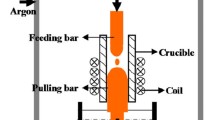Abstract
The influence of oxygen content on the microstructure and mechanical properties of Ti-23Nb-0.7Ta-2Zr (at%) alloy in as-cast and cold-rolled states was investigated systematically in this paper. It is found that the alloy containing oxygen element is only composed of a single β phase, while the alloy without oxygen element consisted of β and α″ phases. Although the grain size becomes larger, the elastic deformation ratio, strength, and hardness of the alloy are all increased with an increase of oxygen content. The as-cast alloy has excellent plastic deformation ability, but the cold-rolled alloy containing oxygen element exhibits brittle characteristics. A conclusion can be drawn that oxygen element can stabilize β phase, inhibit the phase transformation from β to α″, and furthermore help to increase the strength and elastic deformation ability of the alloy.
Similar content being viewed by others
References
S. Ankem and C.A. Greene, Recent developments in microstructure/property relationships of beta titanium alloys, Mater. Sci. Eng. A, 263(1999), p.127.
T. Kasuga, M. Nogami, M. Niinomi, and T. Hattori, Bioactive calcium phosphate invert glass-ceramic coating on β-type Ti-29Nb-13Ta-4.6Zr alloy, Biomaterials, 24(2003), p.283.
M. Abdel-Hady, K. Hinoshita, and M. Morinaga, General approach to phase stability and elastic properties of β-type Ti-alloys using electronic parameters, Scripta Mater., 55(2006), p.477.
T. Saito, T. Furuta, J.H. Hwang, S. Kuramoto, K. Nishino, N. Suzuki, R. Chen, A. Yamada, K. Ito, Y. Seno, T. Nonaka, H. Ikehata, N. Nagasako, C. Iwamoto, Y. Ikuhara, and T. Sakuma, Multifunctional alloys obtained via dislocation-free plastic deformation mechanism, Science, 300(2003), p.464.
T. Furuta, S. Kuramoto, J.H. Hwang, K. Nishino, and T. Saito, Elastic deformation behavior of multi-functional Ti-Nb-Ta-Zr-O alloys, Mater. Trans., 46(2005), p.3001.
S. Kuramoto, T. Furuta, J.H. Hwang, K. Nishino, and T. Saito, Elastic properties of Gum Metal, Mater. Sci. Eng. A, 442(2006), p.454.
M.Y. Gutkin, T. Ishizaki, S. Kuramoto, and I.A. Oviďko, Nanodisturbances in deformed Gum Metal, Acta Mater., 54(2006), p.2489.
S. Kuramoto, T. Furuta, J.H. Hwang, K. Nishino, and T. Saito, Plastic deformation in a multifunctional Ti-Nb-Ta-Zr-O Alloy, Metall. Mater. Trans. A, 37(2006), p.657.
M.Y. Gutkin, T. Ishizaki, S. Kuramoto, I.A. Oviďko, and N.V. Skiba, Giant fault in deformed Gum Metal, Int. J. Plast., 24(2008), p.1333.
E. Withey, M. Jin, A. Minor, S. Kuramoto, D.C. Chrzan, and J.W. Morrism Jr, The deformation of “Gum Metal” in nanoindentation, Mater. Sci. Eng. A, 493(2008), p.26.
T. Yano, Y. Murakami, D. Shindo, and S. Kuramoto, Study of the nanostructure of Gum Metal using energy-filtered transmission electron microscopy, Acta Mater., 57(2009), p.628.
J.W. Morris Jr, Y. Hanlumyuang, M. Sherburne, E. Withey, D.C. Chrzan, S. Kuramoto, Y. Hayashi, and M. Hara, Anomalous transformation-induced deformation in 〈110〉 textured Gum Metal, Acta Mater., 58(2010), p.3271.
S. Kuramoto, T. Furuta, J.H. Hwang, et al., Ti-2003 science and technology, [in] Proceedings of 10th World Conference on Titanium, Hamburg, 2004, p.1527.
Q.Q Wei, L.Q. Wang, Y.F. Fu, J.N. Qin, W.J. Lu, and D. Zhang, Influence of oxygen content on microstructure and mechanical properties of Ti-Nb-Ta-Zr alloy, Mater. Des., 32(2011), p.2934.
F.Q. Hou, S.J. Li, Y.L. Hao, and R. Yang, Nonlinear elastic deformation behaviour of Ti-30Nb-12Zr alloys, Scripta Mater., 63(2010), p.54.
J.I. Qazi, B. Marquardt, L.F. Allard, and H.J. Rack, Phase transformations in Ti-35Nb-7Zr-5Ta-(0.06–0.68)O alloys, Mater. Sci. Eng. C, 25(2005), p.389.
M. Tahara, H.Y. Kim, T. Inamura, H. Hosoda, and S. Miyazaki, Lattice modulation and superelasticity in oxygen-added β-Ti alloys, Acta Mater., 59(2011), p.6208.
Q.S. Zhang, H.F. Zhang, B.Z. Ding, and Z.Q. Hu, Compressive fracture of Zr55Al10Ni5Cu30 bulk amorphous alloy at high temperature, Mater. Sci. Eng. A, 360(2003), p.280.
Z.Q. Liu, R. Li, H. Wang, and T. Zhang, Nitrogen-doping effect on glass formation and primary phase selection in Cu-Zr-Al alloys, J. Alloys Compd., 509(2011), p.5033.
Author information
Authors and Affiliations
Corresponding author
Rights and permissions
About this article
Cite this article
Duan, Hp., Xu, Hx., Su, Wh. et al. Effect of oxygen on the microstructure and mechanical properties of Ti-23Nb-0.7Ta-2Zr alloy. Int J Miner Metall Mater 19, 1128–1133 (2012). https://doi.org/10.1007/s12613-012-0681-4
Received:
Revised:
Accepted:
Published:
Issue Date:
DOI: https://doi.org/10.1007/s12613-012-0681-4




